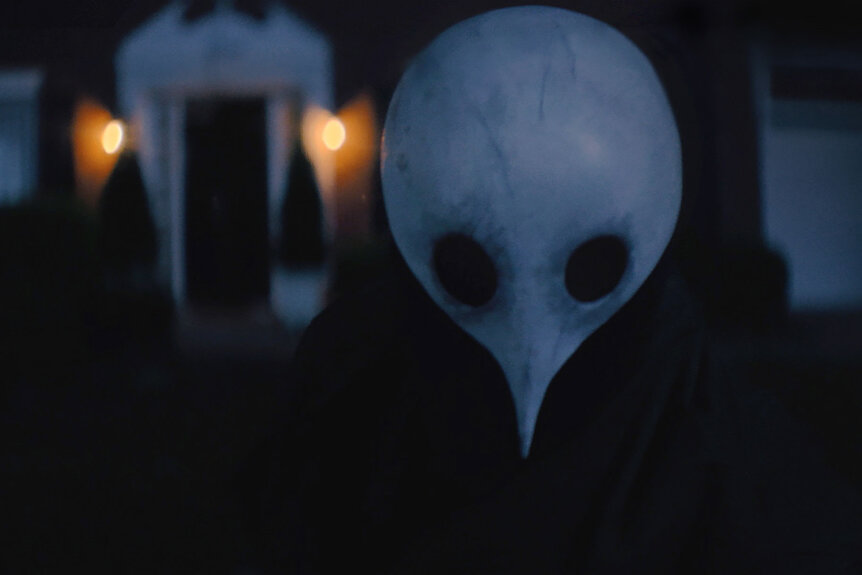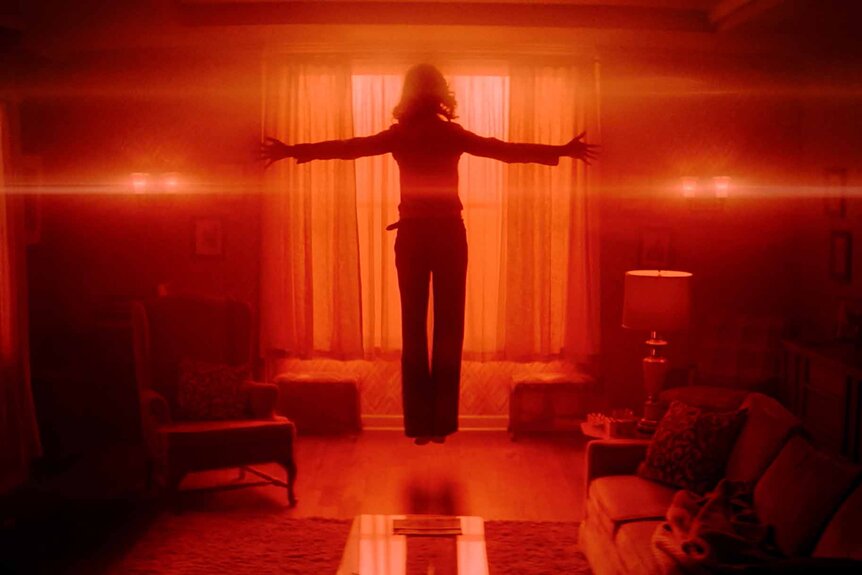The Real-World Satanic Panic that Inspired Peacock's Hysteria!
Something wicked happened in the 1980s, but it wasn't supernatural.
Peacock’s new horror thriller starring Bruce Campbell and Julia Bowen, Hysteria!, takes place in Happy Hollow, a small Michigan town shocked by the disappearance of the star high school quarterback and the seemingly Satanic symbols surrounding the crime. The series, created by Matthew Scott Kane and David A. Goodman, takes viewers back to the 1980s and the height of cultural fear of the occult in the United States.
Meanwhile, the members of teenage heavy metal band Dethkrunch use the sudden interest in the demonic to bolster their brand, hoping it will rocket them to rock and roll superstardom. Instead, they get swept up in a collective panic involving an actual killer and (possibly) supernatural forces. The events of Hysteria! Are wholly fictional, but the moral panic at its center was and is real.
In the real world, the Satanic Panic swept across the nation throughout the 1980s and mid-’90s. Thousands of people were swept up in largely unsubstantiated accusations of Satanic ritual abuse, and the shadow of that panic still hangs over us today.
What was the Satanic Panic, and why did it happen?
By 1980, the United States was reckoning with the recent realization that child abuse, specifically child sexual abuse, was more prevalent than anyone previously realized. The data suggested at the time, as it does today, that the majority of abuses are perpetrated by people close to the child, often family members.
At the same time, American society was going through a change. Families that used to be able to survive on a single income, now needed two. Both parents were entering the workforce, and childcare fell increasingly to daycare facilities. It created a powder keg of anxieties marrying the fear of abuse with the fear of entrusting your children to strangers.
The ostensibly non-fiction book Michelle Remembers, published in 1980, also helped fuel the fires of moral panic. It was written by Canadian psychologist Lawrence Pazder and a former patient of his (later his wife), Michelle Smith. In it, Smith recalls childhood memories recovered through hypnosis of horrific abuse carried out by Satanists. The book became a bestseller and helped lay the foundation in the cultural consciousness for a new boogeyman: the Satanist.
In 1983, a parent in Manhattan Beach, California accused an employee of McMartin Preschool of abusing her child. In response, the local police sent a letter to roughly 200 families, all with children who presently attended McMartin or had attended in the past. The latter asked parents to question their kids, asking whether they had witnessed or been the victim of any abuse. Then they brought in therapists to interview the children about their experiences, often asking leading questions. Those interviews unearthed claims of flying employees, animal sacrifices, and a series of tunnels beneath the daycare. No evidence supporting those claims was ever found.
The supposed occult threat laid out by Michelle Remembers was taken so seriously that some police departments and social workers used it as a training manual for identifying occult abuses. Instead of finding abuses, they instead unintentionally invented them. “What I think we end up with is adults going in with a story and then getting children to confirm it,” Sarah Marshall, host of the podcast You’re Wrong About told Vox.
Three years later, charges were filed against seven McMartin Preschool employees, citing more than 100 counts of abuse and conspiracy. The original 115 counts were later expanded to 321 and involved alleged abuses of 48 children. Charges were dropped against five of the defendants, noting insufficient evidence. By then, confidence about whether anything had happened at all, let alone an elaborate Satanic conspiracy, was waning, but the case had become a force of its own. Prosecutors may have felt they couldn’t drop it under the weight of national scrutiny. In the end, no one was convicted.
Others around the country weren’t as lucky. Dozens of people were convicted of supposedly Satanic crimes before the decade was out, some of whom have since been released. In the early ‘90s, a study of the Satanic conspiracy was undertaken to quantify and validate the abuses. The study uncovered more than 12,000 cases of alleged Satanic ritual abuse, none of which could be substantiated.
They concluded that while individuals sometimes use the imagery or language of Satanism in the commission of their crimes, there is no evidence of an organized network of Satanic cults systematically abusing children. It’s more likely that children felt pressured to weave wild tales by adults influenced by a growing cultural narrative. Big screen horror movies may have also played a part in influencing the details of the Satanic Panic. Joseph Laylock, author of Satanism from Cambridge University Press suggested the public may have been primed by movies like The Exorcist and The Omen, saying that hypnotized patients “seemed to be recalling scenes from these films.”
While the ‘80s-era Satanic Panic eventually died down, it never really died out. The same themes could be seen circa 2016, in the Pizzagate conspiracy theory. In fact, the details of that more recent series of accusations is almost identical to the McMartin Preschool case. The only major difference is that this time the people accused were politicians and celebrities, not daycare teachers. Pizzagate proponents alleged that kids were being taken and abused in Satanic rituals not in a daycare, but a pizza joint. They even alleged a series of underground tunnels beneath the Comet Ping Pong pizzeria in D.C.; the restaurant doesn’t even have a basement.
If we take a wider look at history not just in the United States but around the world, the occult anxiety of the ‘80s and ‘90s wasn’t the first Satanic Panic, and Pizzagate won’t be the last. We whip ourselves into a moral frenzy every now and again and when we do, we tend to lean on familiar cultural trappings of evil. It’s hard to say when the next big moral panic will happen or who the targets will be, but it’s a safe bet that whenever it is and whoever they are, we’ll accuse them of serving the devil.
When does Hysteria! premiere on Peacock?
All eight episodes of Hysteria! are now streaming exclusively on Peacock. Episodes also air weekly, every Thursday night at 10:30 p.m. ET on USA Network.





















